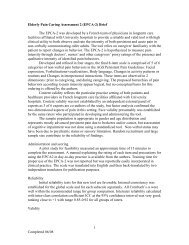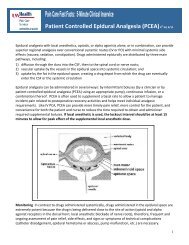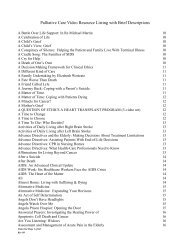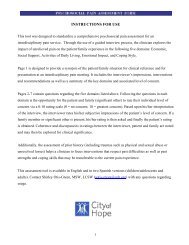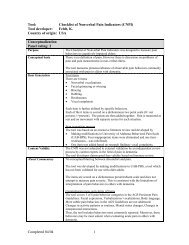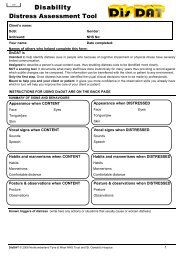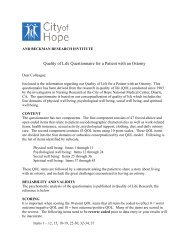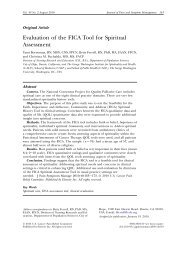Pain Assessment in Advanced Dementia - Pain Resource Center
Pain Assessment in Advanced Dementia - Pain Resource Center
Pain Assessment in Advanced Dementia - Pain Resource Center
You also want an ePaper? Increase the reach of your titles
YUMPU automatically turns print PDFs into web optimized ePapers that Google loves.
Source of evidenceWarden, V., Hurley, A.C., Volicer, L. (2003). Development and psychometric evaluation of the <strong>Pa<strong>in</strong></strong><strong>Assessment</strong> <strong>in</strong> <strong>Advanced</strong> <strong>Dementia</strong> (PAINAD) Scale. Journal of the American Medical Directors,Jan/Feb, 9-15.Lane, P., Kuntupis, M., MacDonald, S., McCarthy, P., Panke, J., Warden, V., Volicer, L. (2003). A pa<strong>in</strong>assessment tool for people with advanced Alzheimer’s and other progressive dementias. HomeHealthcare Nurse, 21(1), 32-37.DeWaters, T., Faut-Callahan, M., McCann, J. J., Paice, J. A., Fogg, L., Holl<strong>in</strong>ger-Smith, L., et al. (2008).Comparison of self-reported pa<strong>in</strong> and the PAINAD scale <strong>in</strong> hospitalized cognitively impaired and<strong>in</strong>tact older adults after hip fracture surgery. Orthopaedic Nurs<strong>in</strong>g / National Association ofOrthopaedic Nurses, 27(1), 21-28.Costardi, D., Rozz<strong>in</strong>i, L., Costanzi, C., Ghianda, D., Franzoni, S., Padovani, A. & Trabucchi, M. (2006).The Italian version of the pa<strong>in</strong> assessment <strong>in</strong> advanced dementia (PAINAD) scale. Archives ofGerontology and Geriatrics, 44(2), 175-180.Hutchison, R., Tucker, W., Kim, S. & Gilder, R. (2006). Evaluation of a behavioral assessment tool for the<strong>in</strong>dividual unable to self-report pa<strong>in</strong>. American Journal of Hospice and Palliative Medic<strong>in</strong>e, 23(4),328-331.Leong, I., Chong, M. & Gibson, S. (2006). The use of a self-reported pa<strong>in</strong> measure, a nurse-reported pa<strong>in</strong>measure and the PAINAD <strong>in</strong> nurs<strong>in</strong>g home residents with moderate and severe dementia: a validationstudy. Age and Age<strong>in</strong>g, 35, 252-256.Schuler, M., Becker, S., Kaspar, R., Nikolaus, T., Kruse, A. & Basler, H. (2007). Psychometric propertiesof the German “<strong>Pa<strong>in</strong></strong> Assesssment <strong>in</strong> <strong>Advanced</strong> <strong>Dementia</strong>” (PAINAD-G) <strong>in</strong> Nurs<strong>in</strong>g Home residents.American Medical Directors Association, July, 388-395.Van Iersel, T., Timmerman, D. & Mullie, A. (2006). Introduction of a pa<strong>in</strong> scale for palliative care patientswith cognitive impairment. International Study of Palliative Nurs<strong>in</strong>g, 12(2), 54-59.Zwakhalen, S., Hamers, I. & Berger, M. (2006). The psychometric quality and cl<strong>in</strong>ical usefulness of threepa<strong>in</strong> assessment tools for elderly people with dementia. <strong>Pa<strong>in</strong></strong>, 126, 210-220.Cohen-Mansfield, J. & Lipson, S. (2008). The utility of pa<strong>in</strong> assessment for analgesic use <strong>in</strong> persons withdementia. <strong>Pa<strong>in</strong></strong>, 134(1-2), 16-23.Key to panel rat<strong>in</strong>g3= Available evidence is strong2= Available evidence supports need for further test<strong>in</strong>g1= Available evidence is <strong>in</strong>sufficient and/or tool revisions are needed0= Evidence is absentContact address for tool developer:Victoria Warden, RNGRECC (182B)E. N. Rogers Memorial Veterans Hospital, 200 Spr<strong>in</strong>gs Road, Bedford, MA 01730.E-mail: Victoria.Warden@med.va.gov.Evaluation completed by:K. Herr, S. Decker, K. Bjoro, University of Iowa.Reviewed 04/04Revised 06/0810




